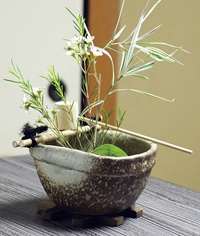Earthenware - Japanese Traditional Culture | History
TOP -- History
History
Timeline
Year |
Period |
Events |
| Before 300 B.C. | JOMON | Jomon pottery, made using coils or slabs, and fired in outdoor bonfires/ditches; characterized by chord-marked pottery; hunting and gathering lifestyle. |
| 300 B.C. to 300 A.D. | YAYOI | Introduction of iron/bronze; development of coil-built pottery known as Yayoi; use of finer alluvial clays to produce thinner-walled shapes; techniques may have come from Korea or China; rice cultivation; Eastern Han and Three Kingdoms Period in China. |
| 300 A.D. to 710 A.D. | KOFUN or YAMATO | Introduction of anagama (sloping tunnel kiln) from Korea; introduction of the potter's wheel; introduction from Korea of Sueki ware; introduction from Korea of three-color ware (green, brown, white); introduction of Buddhism. |
| 710 A.D. to 794 A.D. | NARA or TENPYO | Nara Sansai style (three-color glaze); Japanese fully start using glaze to decorate their wares with colors; flowering of Buddhism. |
| 794 A.D. to 1192 A.D. | Heian | Major period of creativity; introduction of Tokoname (9th century); spread of China's celadon and green glaze (ryokuyuto) to Japan during China's Sung Dynasty (960-1270); introduction of Bizen; Shiki-style pottery introduced; Korea's Korai jawan style (slip inlay, or zogan) appears; green glaze and ash glaze become more popular than three-color glaze; Sanage ware (green glaze) becomes widespread. |
| 1192 A.D. to 1333 A.D. | KAMAKURA | Introduction of Shigaraki style and Seto style; further development of Bizen; new Buddhist sects introduced, including Zen and Lotus Sutra sect of Nichiren; Yuan Dynasty China; Magna Carta signed in England. |
| 1333 - 1573 Medieval Period |
MUROMACHI North/South Courts Warring States |
Seto ware reaches its golden age in early 14th century; Bizen enters golden age in late Muromachi Period; Mishima-style chawan first mentioned in Japanese records; Japanese tea ceremony becomes major conduit of cultural taste, and together with Zen, causes great interest in Bizen, Tanba, Shigaraki and Echizen tea ware; Columbus discovers America. |
| 1573-1603 | MOMOYAMA AZUCHI Periods | Golden Age of Bizen pottery continues; introduction of Hagi style; tea utensils become more popular; introduction of Iga; introduction of Karatsu, Takatori, Agano, and Satsuma wares; start of Mino Ware. (Shino, Oribe, Ki-Seto, Setoguro) |
| 1603 – 1867 (1688 - 1703) |
Edo (Genroku period) |
Introduction of porcelain with Imari, Ko-Kutani, Nabeshima, Kutani, and Sometsuke); start of Kyo-yaki style by Ninsei and Kenzan; nobirigama kilns and porcelain kilns largely replace the anagama; popularity of Mino and Bizen wares declines. |
| 1868 to 1912 | MEIJI | Japan undergoes industrialization. |
| 1912 to 1926 | TAISHO | World War I; representative potters include Kusube Yaichi (1897-1984), Kawai Kanjiro (1890-1966) and Hamada Shoji (1894-1978). |
| 1926 to 1988 | SHOWA | World War II; start of Mingei Movement in 1926 (folk craft movement); start of Sodeisha Movement in 1948 and its focus on sculptural forms, led by Yagi Kazuo (1918-1979) and Suzuki Osamu (1926-); revival of anagama kilns starting in the 1960s; representive potters of Showa Era include Itaya Hazan (1872-1963), Tomimoto Kenkichi (1886-1963), Kanashige Toyo (1896-1967), Arakwa Toyozo (1894-1985), and Kato Tokuro (1898-1985). |
| 1989 to Present | HEISEI | Current Period |
Copyright© Earthenware All Rights Reserved.
